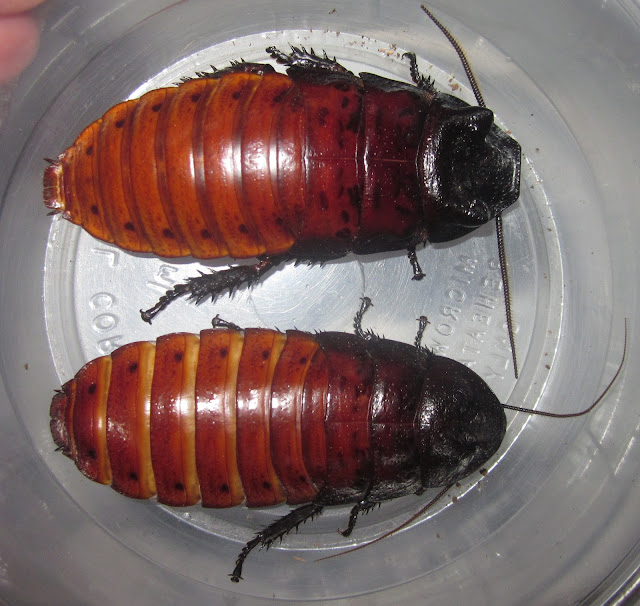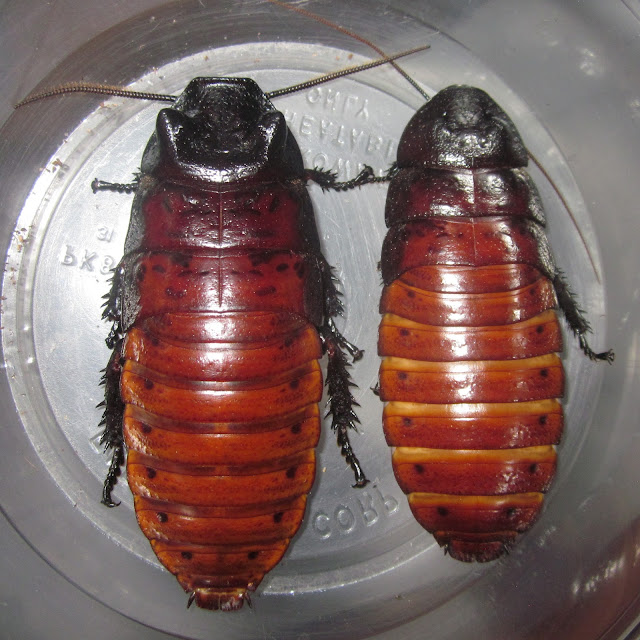Roachcrossing Winter '23 Package Series Pt. 1/5
Well, got another box from Kyle at
Roachcrossing, and lots of new species to show off! 😁 Today let's start with an old hobby classic, but not one I've had the pleasure of keeping until now;
Gromphadorhina portentosa "1972 Cleveland Aquarium".
Kyle was kind enough to send me a large adult pair of this, probably the oldest reliably pure
G.portentosa stock maintained in the US (and the stock that the "LLE Mahogany" morph was isolated from). Adults, particularly adult males of the original Cleveland stock get quite large compared to hybrid "
portentosa" lines (and oddly dwarf the Mahogany morph too). So, I wanted to compare a major male of this stock, to a major male "Masoala"
portentosa, since my majors from that strain have been very large and impressive as well. Plus, the two strains seem to have different major male pronotum structure, which is rather interesting, so I wanted to get some good comparison shots in that regard as well.
I've got my pair set up in a well ventilated container with a thin layer of coconut fiber as the substrate, and bark and cardboard rolls for hides. I'm keeping one third of the setup humid, the rest bone dry, and have them at around 75-85F°. I'm feeding them dog food and fruits.
Here are some pictures of the "Cleveland" pair, and comparison shots between the males of this strain and "Masoala":
 |
| Male "Cleveland" |
 |
| Female "Cleveland" |
 |
| "Cleveland" Pair |
 |
| "Masoala" male (Left) VS "Cleveland" male (Right) |
 |
| "Masoala" male (Top) VS "Cleveland" male (Bottom) |
 |
| "Masoala" male (Bottom) VS "Cleveland" male (Top) |
Some key notes/differences between the two strains I noticed:
- I really love the "Cleveland" coloration, very clean and a bit darker of an orange coloration on the abdomen than I typically see with the "Masoala" line (at least regarding the males, some "Masoala" females are quite dark, though they are usually more dark red than dark orange).
- Additionally, pretty much every adult of the "Masoala" line I've seen has orange/yellowish spots on their thoracic pads, whereas it seems most, if not all "Cleveland" adults have completely black thoracic pads with no spots. The middle of the metanotum and mesonotum for both these lines of portentosa have a big orange patch in the middle though, with some darker spotting inside.
- The pronotums of the "Cleveland" males seem to be stouter and broader than the pronotums of "Masoala" males, though oddly this "Cleveland" male has noticeably larger and bulkier horns than any of my "Masoala" males, even though the "Masoala" male in these pictures is actually larger than the "Cleveland" male! 😂
Those were just the most obvious differences I could see between the two stocks, I'm sure I'll notice more over time as I get offspring from the "Cleveland" stock and have more individuals available for comparison.
Just a little PSA, I've noticed that with the new, larger image size on my blog posts, it's become a bit harder to see the captions I occasionally put under images. Now, I'm not going back through the past 700+ posts on this blog to fix this issue in past posts, so y'all will just have to squint or zoom in to read older image captions (they're not THAT tiny to begin with anyways). 😅 BUT, from here on out I'll put image captions in bold, which should fix this issue and make it easier for people to read. Just figured I'd mention this little change.
Well, that's gonna do it for this post, thanks for reading, hope everyone enjoyed, stay safe, and I'll see you all next time! 😉





















No comments:
Post a Comment